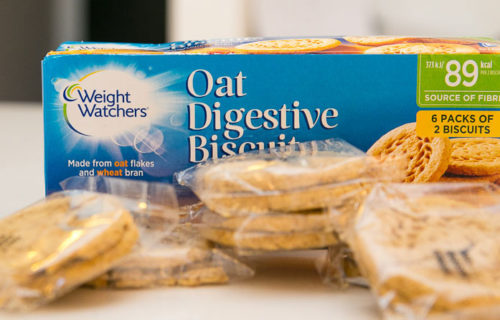WHAT IS THE CAMBRIDGE DIET?
The Cambridge Diet is a weight-loss plan offering nutritional counseling, pre-packaged meals, and low-calorie recipes to its users. This program falls into a special category of diets known as VLCDs (Very Low-Calorie Diets); in fact, no adherent to the Cambridge Diet can consume more than 1500 calories per day. The plan came about in the 1950s and 1960s when Dr. Alan Howard became intensely interested in weight loss and obesity.
For individuals who fit a certain gender and weight loss profile, the recommended caloric intake drops to just 415. This is barely a third of the bare minimum advised by the experts at Livestrong.com. In short, the Cambridge Diet is more than a VLCD; it’s an SD (Starvation diet).
CAMBRIDGE DIET INGREDIENTS
The Cambridge Diet provides users with prepackaged rice, pasta, soups, desserts, replacement shakes, and a variety of other snacks. According to the official website, these foods: ““contain the vitamins and minerals you need for balanced nutrition and healthy weight loss”
But, are these ingredients safe? Maybe not. These prepackaged foods commonly include the following controversial ingredients:
- Maltodextrin: This is a white powder, typically used as a filler, made of ground up corn, rice, or wheat.
- Refined Fractionated Palm Oil: This is what results when you run raw palm oil through filtration and crystallization processes. The resulting liquid contains roughly 40 percent unsaturated and 60 percent saturated fat.
- Sucralose: This is a non-caloric sweetener about 1000 times sweeter than natural table sugar. A study performed by Duke University revealed that overuse of Sucralose produces “numerous adverse effects.”
- Guar Gum: A fiber extract derived from the guar plant. Guar gum is used as a thickener and a laxative. Its side effects include diarrhea, gas, stomach pain, nausea, and indigestion.
- Acesulfame K: This artificial sweetener is about 200 times sweeter than standard table sugar. A study showed that extended use affected insulin levels, altered neurometabolic functions, changed sweetness preferences, and affected cognitive abilities.
- Carrageenan: A binder and thickener extracted from red seaweed. Research at the University of Iowa determined that this ingredient has carcinogenic and ulcerative properties.
- Flavorings: The company provides no further information on what these ‘flavorings’ entail. Side effects are unknown.
CAMBRIDGE DIET QUALITY OF INGREDIENTS
Since Cambridge limits dieters to the company’s prepackaged foods for much of their weight loss journey, it’s important that these meals provide wholesome, quality nutrition. Unfortunately, that does not seem to be the case. Cambridge makes ample use of cheap thickeners and artificial sweeteners across its snacks and drinks. A variety of studies has shown that such additives actually make weight loss harder.
The British Dietetic Association reviewed the Cambridge Diet. They found that the diet produces ““bad breath, a dry mouth, tiredness, dizziness, insomnia, nausea, and constipation”. They also add that adherents to this diet need to be in constant contact with a medical professional. The extremely low number of calories in stage one and stage two can produce life-threatening side effects. It’s unlikely that the diet’s counselors are trained to provide support for such drastic calorie reduction.
THE SIX STEPS OF THE CAMBRIDGE DIET
This weight-loss plan has six distinct stages:
- Sole Source: You will eat three or four prepackaged foods per day. You have two options: eating three prepackaged foods and a single meal of 200 calories or less or eating four meals and drinking up to 200 ml of skim milk.
- Second Stage: You can add protein rich meals, skimmed milk, and fresh vegetables to your Cambridge items. However, you are restricted to a daily caloric intake of just 810 calories. The second stage lasts approximately one week.
- Third Stage: The diet now allows up to 1,000 calories and two prepackaged meals per day. Most dieters stay in stage three for around two weeks.
- Fourth Stage: The diet now allows you to eat more regular meals.
- Fifth Stage: You can now eat up to 1,500 calories per day. This allows for one Cambridge meal, lunch, breakfast, dinner, and a snack.
- Sixth Stage: This is the maintenance stage of the Cambridge Diet. Once you reach your target weight, the program recommends you eat one prepackaged meal a day and continue to meet regularly with a Cambridge consultant.
The website does not disclose the background or education of its consultants. So, if you choose to pursue the Cambridge diet, take their advice with a grain of salt.
THE PRICE AND QUALITY OF THE CAMBRIDGE DIET
The total price of this diet depends on the number of prepackaged meals ingested. The official website states that a typical dieter will spend 48.30 pounds per week; this converts to about 57 dollars. Since this is a plan developed for the UK, however, there is no support offered for the US or North American markets.
As outlined above, the meals are of poor quality and chock-full of unhealthy additives and thickeners. Additionally, as the maintenance stage requires one prepackaged meal per day, this plan becomes quite expensive over the long-term. At this time, DiT does not believe the diet’s limited results justify its high price tag.
BUSINESS OF CAMBRIDGE DIET
You can contact the Cambridge Diet by:
Phone: (44)(0) 1536 403344
Snail Mail:Stafford House, 10 Brakey Road, Corby, Northants, NN17 5LU
Email: admind@cambridgeweightplan.co.uk
The official website outlines what it takes to become a paid consultant for the Cambridge Diet. At no point does the company ask for any sort of background in health or nutrition. Instead, the advertisement tries to recruit sales-oriented professionals with a forward-thinking outlook. Therefore, as we suspected, it’s unlikely that the company’s consultants possess any experience supporting individuals struggling with weight loss.
CUSTOMER OPINIONS OF CAMBRIDGE DIET
Here are some quotes pulled directly from customer reviews:
- “Not the best diet health wise… nails went brittle thin, hair began to thin rapidly”
- “Never felt full, I always felt hungry”
- “Having a bad time with motivation”
- “The first few days are the hardest”
- Best weight-loss program for me. I’ve tried numerous other programs like Jenny Craig, Cowens, etc but nothing has worked like this one.
Though some people lost weight, many of them also did so while feeling weak and fatigued. In addition, many people experienced symptoms common in the nutritionally deficient: thin hair, brittle and weak nails, and increased stress. Though there were some weight loss results for people, there were also issues due to a lack of calories. Many felt weakened, less energetic, and much more fatigued than usual.
CONCLUSION – DOES THE CAMBRIDGE DIET WORK?
The Cambridge Diet is typical of many diets which rely on prepackaged food. Though counseling is offered, it comes from sales people, not health experts. While the meals on this plan are low in calories, they’re also chock full of cheap fillers and controversial additives Reviews have been mixed with some experiencing health issues and hunger. Though a low-calorie plan like this can work, any reduction in calories can result in weight loss. There’s nothing special added to the prepackaged foods which aren’t found in a standard processed meal.





















